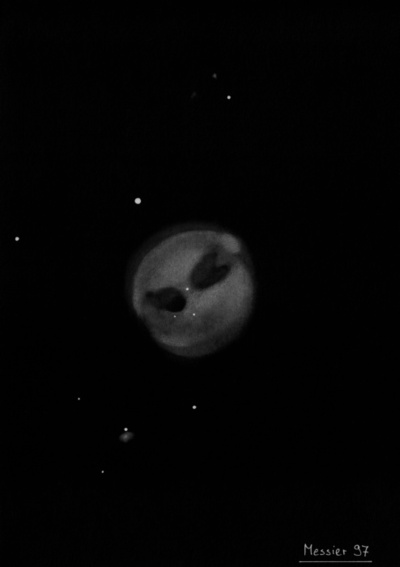Owl Nebula
Owl Nebula

Pierre Méchain discovered M97 = NGC 3587 = h838 on 16 Feb 1781. In 1789 William Herschel described (with his 18.7") "considerably bright, globular, of equal light throughout, with a diminishing border of no great extent. About 3' diameter."
A total of 45 observations were made at Birr Castle. The dark holes were first recorded by assistant William Rambaut on 5 Mar 1848: "Saw two dark and very large spots in middle; Lord Rosse remarked that all round its edge the sky appeared darker than the average." On 11 March, Rosse wrote, "Brilliant star in the centre. After 5 min observation, detected the star to the right, which Dr. Robinson immediately saw. Round each star seems a black space." Rosse's or Rambaut's sketch, made in 1848, showed a distinct spiral structure ("a double perforation appears to partake of the structure both of the annular and spiral nebulae."). He was clearly influenced by the focus on resolving spiral structure in a variety of objects.
Between 1848 and early 1850 Lord Rosse and Johnstone Stoney made additional detailed sketches (one included in the 1850 publication) that vaguely resembled the face of an owl with two large dark holes or "eyes" punctuated by stars (one is the misplaced central star), additional darker streaks and patches, and fuzzy filaments extending out of the sides (perhaps to indicate an irregular fringe). On 13 Apr 1850, Stoney noted that only one star was visible. Wilhelm Tempel was highly critical, though, of Rosse's fanciful sketch when he drew the planetary in 1876 with the 11" refractor at the Arcetri Observatory in Florence.
The nickname "Owl Nebula" was never used by Lord Rosse in a published paper but in 1864 William Darby wrote that M97 was "familiarly known in the Parsontown Observatory as 'the owl nebula' from its resemblance to an owl." For an unusual interpretation of the appearance, Romney Robinson described the planetary on 11 Mar 1848 as "A most intricate group of spiral arcs disposed around two starry centers, looking like the visage of a monkey."
300/350mm - 13.1" (4/29/84): moderately bright, large, round. A single hole west of center is highly suspected.
13.1" (2/25/84): the darker "holes" visible were near the threshold. No central star seen at 166x-220x.
400/500mm - 17.5" (3/12/88): both holes definitely visible at 280x using a UHC filter.
17.5" (2/28/87): fairly bright, very large, round. Two low contrast darker "holes" are visible with averted vision which form the "eyes" of the "Owl Nebula". The southeast hole is darker but the northwest hole appears larger. Central star not visible.
600/800mm - 24" (2/9/13): although I didn't take notes on the structure of M97, the mag 16 central was readily visible using magnifications of 200x and higher.
900/1200mm - 48" (4/19/15): at 375x and 488x w/NPB filter; although the unfiltered view was excellent, adding a NPB filter at 488x ramped up the contrast! The two famous holes were very high contrast with the northwest eye slightly larger with a irregular outline. The slightly darker southeast eye has an easily visible star at the south edge [40" SSE of the central star]. In addition, a third very faint star (best seen unfiltered) is close west of this hole [37" SSE of center]. Overall the surface brightness of the planetary is irregular or mottled. It fades around the periphery creating a dimmer ragged circular rim of uneven brightness. The main bright portion of the planetary is slightly elongated NNW-SSE.
48" (4/15/10): the Owl Nebula was quite impressive at 330x (unfiltered) and exhibited a fascinating amount of detail. The mag 16 central star was easily visible at the center of the 3.4' disc. To the northwest and southeast of the central star are two large, darker "holes" (Owl's "eyes"), each roughly 45" in diameter. The southeast eye has a little more contrast and a very faint star is close to its southeast edge. The northwest eye is a little larger, though not quite as dark in the center. A mag 12 star lies 2.6' NE of center and a mag 14 star lies 3' S of center. MCG +09-19-014, a faint galaxy, lies 3.8' SSE adjacent to a mag 14.5 star. HCG 50 (faintest of the Hickson Compact Groups) lies 20' ESE.
Notes by Steve Gottlieb